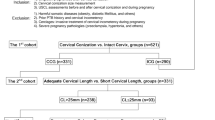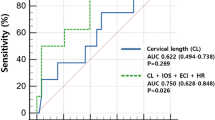Abstract
OBJECTIVE:
To determine whether gravidas with short cervical length on endovaginal ultrasound examination, not in preterm labor, who underwent cervical cerclage have better outcomes compared with those with no cerclage.
METHODS:
This is an observational study in which data were collected prospectively on women who had ultrasound endovaginal cervical length measurement and were not in preterm labor. The subgroup of women who were ≤26 weeks’ at cervical measurement was analyzed separately. Short cervix was defined as ≤30 mm. After delivery, charts were reviewed for management and outcomes, performed at the discretion of the attending obstetrician. Two study groups were defined: those with cerclage and those with no cerclage. Predictor variables were cerclage and cervical lengths. Outcome variables were birth weight, gestational age at delivery, and neonatal outcomes. Data were analyzed using the χ-squared, Fisher’s exact, and Student’s t-tests, a p value of <0.05 was considered to be significant.
RESULTS:
A total of 85 patients with cervical lengths of ≤30 mm were identified; of these 43 had cerclage, and 42 did not. The latter had bedrest, tocolytics, or no intervention. Indications for cervical length measurement were similar in both groups, as were age, insurance status, cervical measurements, preterm premature rupture of membranes, and mode of delivery. The mean gestational age at delivery and birth weight in the cerclage group (34.0 ± 5.4 weeks’; 2530 ± 905 gm) were greater than in the no cerclage group (32.0 ± 6.0 weeks’, 2084 ± 1085 gm, p values of <0.04 and <0.04, respectively). Analysis for the subgroup of women who were ≤26 weeks’ at first measurement revealed similar results. The relative risk for delivering at <30 weeks’ gestation, for incrementally shorter cervices, was less in the cerclage group.
CONCLUSION: Cerclage in gravidas with short cervix measured by endovaginal ultrasound, not in preterm labor, may be associated with neonates of greater gestational age and birth weight, with fewer of these parturients delivering before 30 weeks’ gestation. A prospective randomized trial of treatment modalities for asymptomatic shortened cervix is needed.
This is a preview of subscription content, access via your institution
Access options
Subscribe to this journal
Receive 12 print issues and online access
$259.00 per year
only $21.58 per issue
Buy this article
- Purchase on Springer Link
- Instant access to full article PDF
Prices may be subject to local taxes which are calculated during checkout
Similar content being viewed by others
Author information
Authors and Affiliations
Corresponding author
Rights and permissions
About this article
Cite this article
Hibbard, J., Snow, J. & Moawad, A. Short Cervical Length by Ultrasound and Cerclage. J Perinatol 20, 161–165 (2000). https://doi.org/10.1038/sj.jp.7200333
Published:
Issue Date:
DOI: https://doi.org/10.1038/sj.jp.7200333



